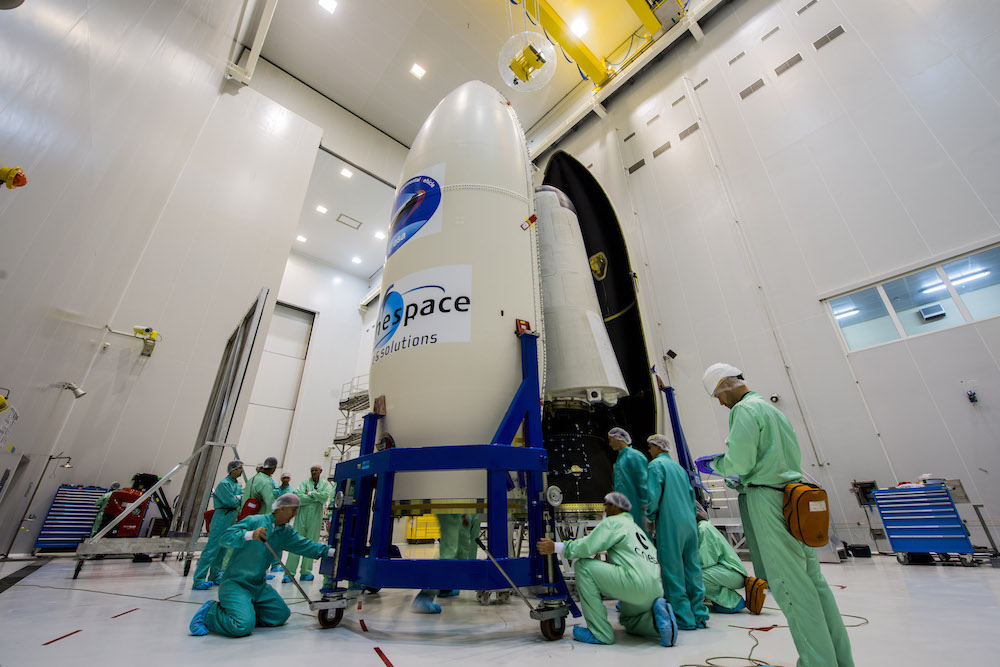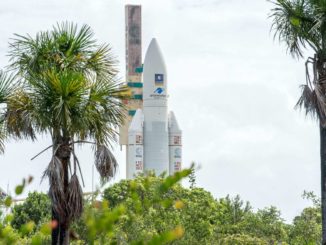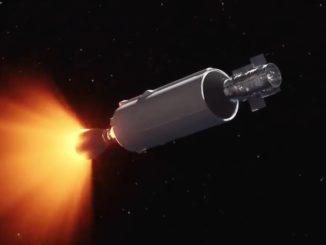.@esa #ixv and #vega finally together for the last preparation phase! #VV04 #100minutemission pic.twitter.com/QMHTViKThh
— ESA IXV (@esa_ixv) January 31, 2015
Launch crews in French Guiana have mounted an innovative European space plane on top of a solid-fueled Vega launcher for a Feb. 11 suborbital test flight.
The European Space Agency’s Intermediate Experimental Vehicle was shrouded inside the Vega rocket’s 8.5-foot (2.6-meter) diameter payload fairing when it rolled out of a processing facility at the Guiana Space Center on a convoy to the Vega launch pad.
Once the composite arrived at the base of the rocket, cranes hoisted the spacecraft in the fairing on top of the four-stage Vega launcher. The attachment of the IXV space plane topped out the Vega rocket at a height of 98 feet and sets the stage for final checkouts before officials give the go for launch.
The mission is set for liftoff from the European-run jungle spaceport in South America on Feb. 11. The two-hour launch window opens at 1300 GMT (8 a.m. EST; 10 a.m. local time).
Assembly of the Vega rocket began Sept. 18 with stacking of the booster’s P80 first stage motor. After the addition of Vega’s solid-fueled second and third stages, the rocket’s Ukrainian-built hydrazine-burning fourth stage was added in mid-October to complete the launcher’s build-up.
The launch was supposed to take off in November, but the flight was grounded to give officials time to complete a safety review to ensure the rocket would not endanger people or property after liftoff.
The launch trajectory of the IXV space plane on a suborbital trajectory will differ from the Vega rocket’s previous flights, which flew north from the space center with satellites heading for high-inclination polar orbits. The launch of IXV will head east from Vega’s launch pad, and the geometry of the French Guiana coastline means it will fly over land in the first phase of the launch sequence.
Officials said they slightly adjusted the launch track to alleviate the safety concern.

Technicians resumed launch preparations in January, completed final preparations on the spacecraft, loaded it with hydrazine maneuvering fuel, configured it for launch, and encapsulated the IXV inside the Vega rocket’s fairing Jan. 28, before transferring the payload to the launch pad at the end of the week.
The IXV mission will last 100 minutes after the Vega launcher sends the 2,000-kilogram (4,409-pound) space plane on a suborbital path around the world, reaching a top speed of 7.5 kilometers per second, or nearly 16,800 mph, and a peak altitude of 420 kilometers, or 261 miles.
Manufactured by Thales Alenia Space, the space plane is outfitted with small rocket thrusters and two aft-mounted aerodynamic flaps to control its path during re-entry. A recovery team in the Pacific Ocean will retrieve the testbed and return it to Europe for inspections.
Data collected on the IXV’s flight could be fed into new ESA programs to give Europe an independent capability to return spacecraft from orbit with precise landings.
The test flight could help European efforts to return samples from other worlds, develop satellite servicing and disposal systems, and craft reusable rocket stages, according to ESA.
The Feb. 11 mission will mark the fourth flight of the lightweight Vega rocket, and the first launch of the year for Arianespace.
Follow Stephen Clark on Twitter: @StephenClark1.



